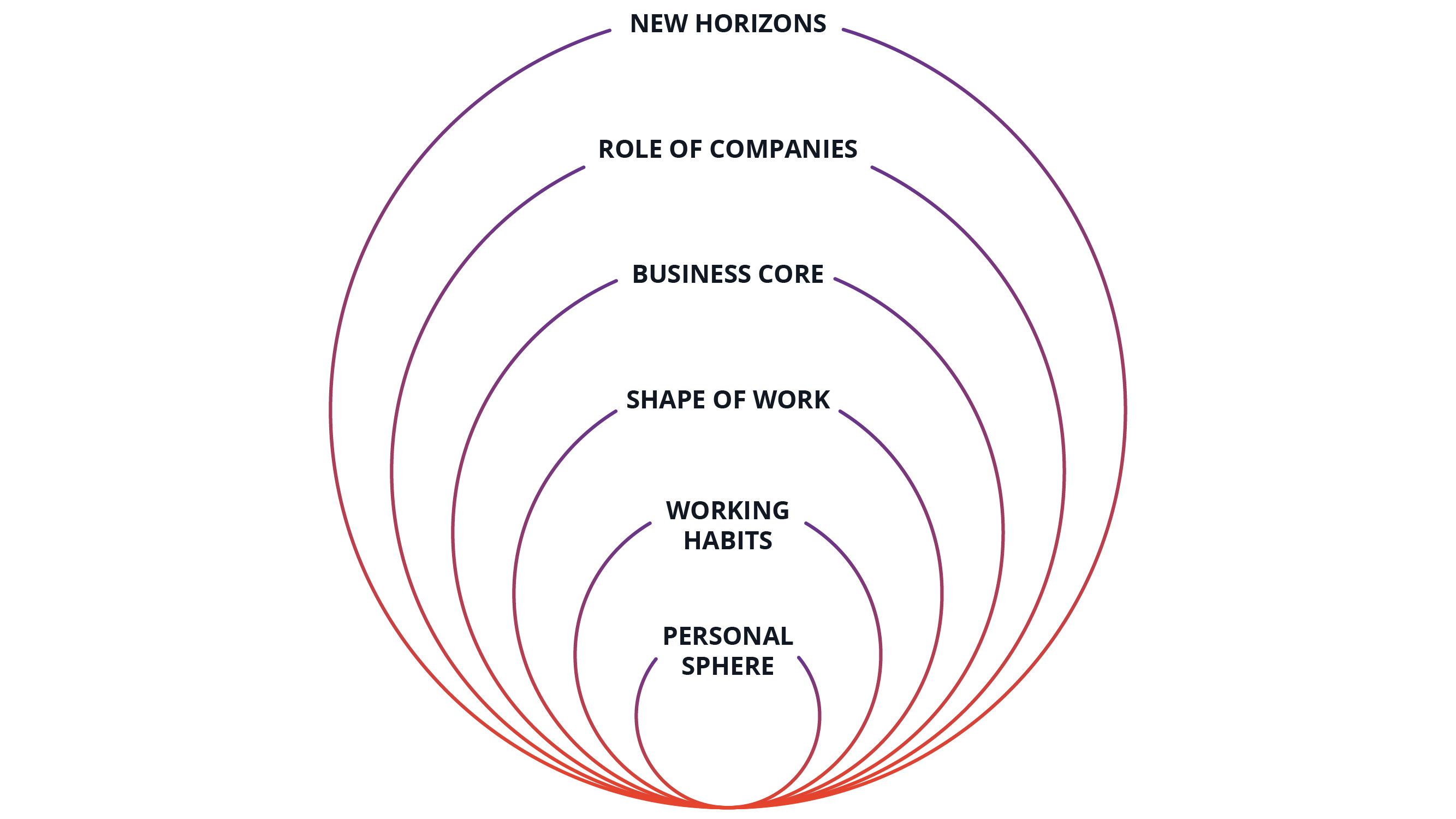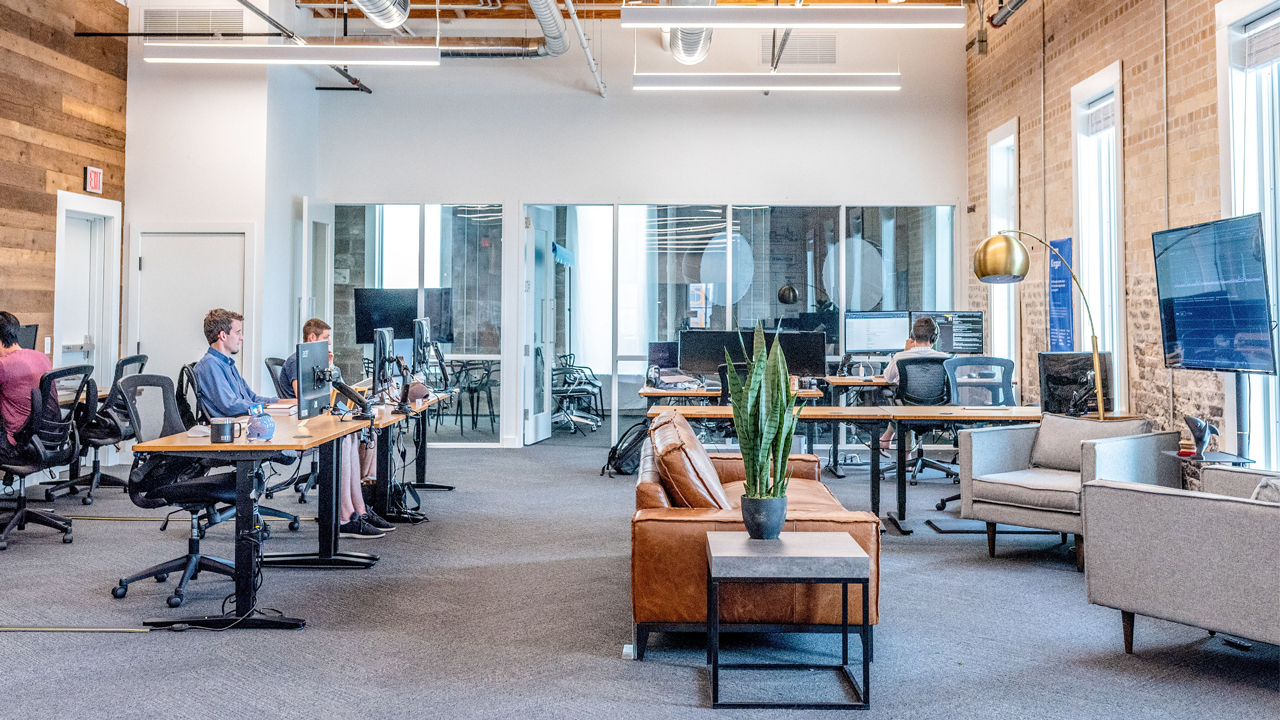Covid-19: relevant implications for organizations
The first stage of the coronavirus crisis is coming to an end, and we all know what it has brought to our societies: lockdowns, office closures, market upheaval, and a sharp economic slump. All this is deeply worrying. The so-called second stage is often described as a path to ‘the new normal’. Yet, despite all hopes surrounding this notion, that’s no less worrying. Many governments and leaders depict this as a phase in which we’ll gradually be allowed to go back to our previous lives – though in a weakened and more limited way (so long as Covid-19 is undefeated). The fact is, for organizations adopting this approach would simply be catastrophic. It would prolong the hardship faced by most companies and doom any real prospect of recovery.
Luckily, there’s another way. A new course that could represent a huge, unprecedented opportunity for organizations. The next stage should not imply going back to one’s past comfort zone but rather looking ahead and boldly embracing the future. Indeed, the virus could prove to be a tremendous driver for change, pushing companies to transform as never before.
However, for this to happen, organizations have to do their part. The benefits indirectly deriving from the shock Covid-19 has inflicted on humankind can only be reaped if executives change the way things are managed, and improve it radically.
Patterns of change

How?
The answer to this question is complex. First, there has to be a total shift, especially of mindset. Organizations have to understand the need for systemic change. Although it has no brain, Covid-19 has proved to be smart enough to cause systemic disruption. Executives must be up to it, and take a broader view. It’s not about just fixing some processes, reshaping a department or buying a new technology. You must completely rethink and redesign how your company works and behaves, in an environment that is now exposed to both digital transformation and pandemic risks. In a way, organizations should be reinvented and suddenly adapted – much quicker than expected – to the new world we are inhabiting today. Second, there’s also a need for a complete redefinition of the relationship with employees. Here the old ways are definitely outdated, and there’s a lot to do.
To be able to perform this change, organizations’ action is urgently needed in five main areas: people, functions, technology, spaces and culture.
People: your employees deserve better
In the pandemic most companies have shown great respect for government guidelines and trade union agreements. Consequently, they have moved quickly to ensure the safety and protection of their employees. Many initiatives on this front are praiseworthy, but that’s not enough. Indeed, your employees represent an extraordinary potential that, in the current situation, is just waiting to be liberated.
Smart working had been on organizations’ back burner for decades. Many doubted it could ever become viable. Then, in a matter of weeks, the coronavirus has pushed millions of people to work from home – and most have proved to be more than ready for the change. Companies had not made any preparations, and actually the forms of smart working that have materialized are far from ideal. But people engaged in admirable ways. Now, organizations should elevate employees’ role by leveraging individual responsibility and collective intelligence.
When people work remotely, the leadership model based on command and control collapses. Executives have to rely much more on trust and the empowerment of their people. As all this happened so quickly, there are actions to take in order to make remote working really smart. But the process has started. Your company can support it to its advantage by taking several important steps:
- Train employees to work by objectives and not by tasks. As you can’t control how tasks are performed by distant workers, leave people free to organize themselves and make them responsible for the outcomes.
- Offer up-skilling and re-skilling. For smart working to function at its best, new skills must be acquired rapidly. As many individuals are already familiar with digital, learning what’s needed to get up to speed could prove less hard than expected.
- Inform employees constantly and in real time. A dispersed workforce risks becoming disoriented. Your internal communication has never been so crucial, and it has to keep people informed and focused all the time.
- Use analytics to optimize smart workers efficiency. By its nature, smart working is highly digitized, so it’s relatively easy to check analytics in order to understand who is good at it and who should preferably go back to the office.
- Make employees work in networked teams. As a recent McKinsey report suggested, in response to the coronavirus and the rapidly changing environment it has created, companies need to act with urgency. This can only be done by an informal network of teams that are empowered to operate outside of the current hierarchy of the organization (McKinsey, To weather a crisis, build a network of teams, April 2020).
- Find how to compensate the lack of socialization. That’s a clear minus of remote working. You should think creatively to introduce social initiatives that can make people converge and unite even when physically separated. Study community management in this perspective.
- Understand people’s psychological problems. Many psychologists have described the mental and emotional difficulties that many have working from home. Just take that into account in your appraisal of the situation.
Help employees rebalance work and life in a smarter way. This is the personal challenge of every remote worker. Your company should strive to be of help, making it easy to find solutions that fit individuals’ needs in all possible ways.
- Redesign the whole employee experience. Although a growing part of the workforce will likely go back to the office in the months ahead, smart working has proved its value and is here to stay. This implies that the employee experience – even the process I designed two years ago in a book with the same title (Employee Experience, Franco Angeli, 2018) – has to be largely reconceptualized. Organizations and analysists should join forces to understand how the new employee experience may look like.
In more general terms, considering the new reality, organizations should motivate their people, and especially the young, with a new sense of purpose. As many have noticed, young talents are only attracted to jobs in which they can find some meaning. This was true even before the shock imposed upon us by Covid-19, but now the relevance of this has become paramount. Another McKinsey report has recently stated that “Purpose can unleash employee potential—helping you win the war for talent, retain your best people, and boost employee motivation. Today, about two-thirds of millennials take a company’s social and environmental commitments into account when deciding where to work” (McKinsey Quarterly, Purpose. Shifting from why to how, April 2020). The doubts lingering on the possible relation between coronavirus’ sudden appearance and the growing unbalances tied to climate change can only reinforce these feelings.
Yet, it’s not just about the young. Assuming a broader view regarding people, organizations should shift their focus from shareholders’ aspirations to stakeholders’ needs. Shareholders (those who own shares in a company) tend to have a keen interest in the organization’s short-term gains. But stakeholders – meant as investors, employees, customers, suppliers, unions, governmental agencies, and the community surrounding the organization – have a long-term and different perspective. They want to know if they can trust the company in its longstanding dedication to social and environmental responsibility. Again, Covid-19 has made this expectation stronger than ever.
Functions: not all may be needed
A surprising effect of the coronavirus disruption is the realization that some organizational functions that were persistently seen as necessary have stopped working with little or no consequences. This raises a big question about their real usefulness. At the same time, other functions have increased their relevance. Assessing what’s really needed (and cutting functional redundancy) has become an important choice for many organizations to make.
How should executives proceed? They have first to understand how the pandemic has impacted all functions inside the company, and then redesign the decision making process accordingly. An efficient way to do this is by adopting tools that may provide revealing evidence. Some of the best are the following:
- Organizational Network Analysis (ONA) is a structured way to visualize how communication, information, and decisions flow through a company, irrespective of how the formal hierarchy is organized. In remote working this analysis can help discover functional anomalies from the collaboration system traffic.
- Experience Mining is a non-intrusive and platform agnostic tool, that employs smart algorithms to analyze data traces and provides a map of real behaviors and processes. It offers powerful capabilities to group similar behaviors in Persona clusters and insightful KPIs to evaluate performances.
This knowledge is precious to grasp the changes that the pandemic has brought to the organization and make the most of remote working. It may also help contain the fragmentation resulting from a scattered workforce and fight the emergence of new silos and sub-silos from the start.
The one function that, in this new organizational context, must be enhanced is internal communication. Its role is becoming essential in order to overcome the cacophony of voices flowing in all directions among remote workers, and provide much needed convergent, unified communication in real time.
Technology: digitization has become mandatory
Covid-19 has given a huge boost to the introduction of tools and devices to collaborate in a smarter way. From November 2019 the adoption of Microsoft Teams has more than doubled, reaching now 44 million daily active users. The rush to virtual meetings caused by the crisis has also attracted many people to tools such as Zoom and Slack, whose adoption has experienced record numbers.
Clearly, this is about not only remote working but also the work done at the office. Technology is needed to optimize all processes and ensure the best possible collaboration among all employees, those located inside the company and those who work from home. In any case, the impact of Covid-19 on people’s lives should be seen as a turning point. Simply, the way employees work and learn will never be the same.
This also means that you should ensure transversal digitization, covering all aspects of your company. The best way to do this is by relying on the backbone of a valid Digital Workplace: a place where people, technology and organization meet, and which provides a unique access point for collaboration and integration with all enterprise systems. This was something very important to implement before the virus advent, and it has now become a mandatory requirement to weather the crisis and look confidently to the future.
In addition to the Digital Workplace, there’s another technology that could be of special help at this time: a clever app, conceived to provide constantly updated information to all employees, and gather information from them. The reason for this is the great need for timely communication. In the age of coronavirus, a missing piece of information can suddenly endanger people’s health.
The greater reliance on digital has a strong implication: cybersecurity will have to be strengthened.
The next normal scenario will probably be characterized by the transfer of more and more activities from the physical to the cyber world. This will entail higher risks, and will require a consolidate risk-based approach to cybersecurity to ensure privacy, business continuity, compliance, and resilience of all business processes.
Spaces: they must be reconsidered completely

By pushing millions of people into remote working, the shock determined by Covid-19 has freed up a lot of office space. Some companies have quickly discovered that they can function pretty well with just 20 percent of the employees sitting at their desk. If this is true, why bear the cost of providing an office to the remaining 80 percent?
This is an open question that will have to find good answers. Naturally, things are a bit more complicated. In the short term, organizations must take into account the required new forms of distancing, sanitization, etc. Employees will have to keep distances and behave in ways that are incompatible with the old forms of working and the crowded spaces that were the norm just a few months ago.
In the long term some of these problems will be eased. But it’s highly uncertain that we’ll ever be able to go back to a carefree use of the same old spaces. According to CNN, American scientists who specialize in bats have recently informed that these nice mammals host some 15.000 coronaviruses, only a few hundred of which are currently known. When another pathogen will jump from a bat to a man and a new pandemic will strike is anyone’s guess.
This implies that we must rethink the role of working spaces and adapt them to the new post-Covid-19 world. From this standpoint, the open space concept that until yesterday seemed so cool for allowing close collaboration among employees has to be totally reviewed. In skyscrapers, the elevators that used to carry 20 people in just a few square meters are now inconceivable, and their destiny is to accept just 2 or 3 properly distanced people at a time. Clearly, this could only make sense if office hours are no more based on the 9-18 routine and employees can enter and leave at any time.
In brief, from now on office spaces and smart working have to be reconceived in a systemic and dynamic perspective. Organizations need to explore new, alternative ways of using spaces and not see the end of the pandemic as a green light for a return to the past.
Culture: the real precondition for change
Coping with the next stage of the crisis will be hard if the organization’s culture doesn’t evolve quickly. A cultural advancement is indeed the prerequisite for any changes to occur in the above mentioned five areas. That’s the reason why implementing a change management process is becoming a choice of strategic value.
Taking into account the current social, economic, and technological environment and the dizzying transformation underway around them, executives should radically check and redefine the organizations’ business models. Besides, while in the past they could indulge with planning over several years, they must now plan in months and weeks. Covid-19 has caused an incredible acceleration in most business practices and processes.
Organizations should strive to involve as many people as possible in this cultural shift. They have to push people to embrace change. They have to provide guidance to help employees learn what smart working really is, or should be. They must also help customers, suppliers, and partners appreciate the new smart working procedures, whose benefits can fall on everyone.
In addition to this, as Barbara Cominelli , COO at Microsoft Italy, said in a recent interview, companies should grasp the potential for innovation and creativity that the new ways of working can imply. The ideal post-virus culture should be open, flexible, agile, keen on collaboration, totally in love with digital, and eager to discover new paths.

 5 May 2020
5 May 2020
